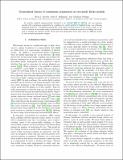Generalized classes of continuous symmetries in two-mode Dicke models
Abstract
As recently realized experimentally [Léonard et al., Nature 543 , 87 (2017)], one can engineer models with continuous symmetries by coupling two cavity modes to trapped atoms, via a Raman pumping geometry. Considering specifically cases where internal states of the atoms couple to the cavity, we show an extended range of parameters for which continuous symmetry breaking can occur, and we classify the distinct steady states and time-dependent states that arise for different points in this extended parameter regime.
Citation
Moodie , R , Ballantine , K & Keeling , J M J 2018 , ' Generalized classes of continuous symmetries in two-mode Dicke models ' , Physical Review. A, Atomic, molecular, and optical physics , vol. 97 , no. 3 , 033802 . https://doi.org/10.1103/PhysRevA.97.033802
Publication
Physical Review. A, Atomic, molecular, and optical physics
Status
Peer reviewed
ISSN
1050-2947Type
Journal article
Description
K.E.B. and J.K. acknowledge support from EPSRC program “TOPNES” (EP/I031014/1).Collections
Items in the St Andrews Research Repository are protected by copyright, with all rights reserved, unless otherwise indicated.

